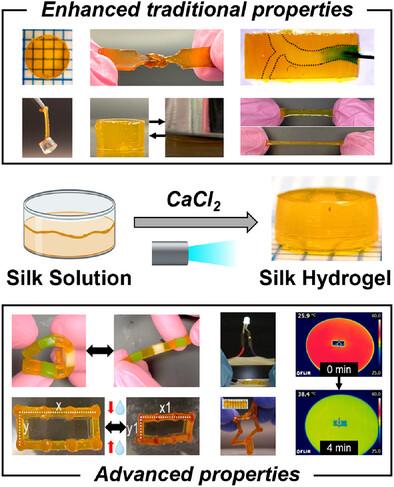Calcium Imparts Advanced Functionalities to Silk Hydrogels for Biofabrication and Biomedical Innovation
IF 19
1区 材料科学
Q1 CHEMISTRY, MULTIDISCIPLINARY
引用次数: 0
Abstract
Photocrosslinked silk hydrogels offer a versatile platform for biomedical applications, thanks to their elasticity and compatibility with advanced manufacturing techniques. Here, a rapid and scalable strategy to enhance di-tyrosine photocrosslinking by incorporating calcium ions (Ca2⁺), inspired by their role in natural silk spinning, is presented. Using a visible-light based photoinitiating system, Ca2⁺-supplemented hydrogels demonstrate superior transparency, stretchability, and toughness, supporting high-fidelity digital light processing and volumetric printing. These silk inks remain stable and printable after extended storage at room temperature, enabling on-demand fabrication and eliminating the need for the cold chain. Notabl2⁺ imparts humidity-responsive and adhesive properties, as well as strong interlayer bonding. This enables the creation of modular, multizonal, and multilayered constructs, which can be permanently fused via autoclaving. Beyond structural advantages, silk-calcium hydrogels exhibit enhanced thermal diffusivity and electrical conductivity, making them suitable for passive cooling and bioelectronic interfaces. Subcutaneous implantation in mice confirms biocompatibility. This work introduces a multifunctional silk hydrogel platform with rapid photocrosslinking, long-term ink stability, and modular assembly capabilities, advancing the design of stimuli-responsive biomaterials for tissue engineering, wound healing, and wearable technologies.

钙赋予丝水凝胶生物制造和生物医学创新的先进功能
由于其弹性和与先进制造技术的兼容性,光交联丝水凝胶为生物医学应用提供了一个多功能平台。在这里,提出了一种快速且可扩展的策略,通过加入钙离子(Ca2 +)来增强二酪氨酸光交联,灵感来自于它们在天然丝纺丝中的作用。使用基于可见光的光引发系统,Ca2 +补充的水凝胶表现出卓越的透明度、拉伸性和韧性,支持高保真数字光处理和体积印刷。这些丝质油墨在室温下长期储存后保持稳定和可印刷,使按需制造和消除对冷链的需要。值得注意的是,2 +具有湿度响应性和粘附性,以及很强的层间粘合性。这样就可以创建模块化、多区域和多层结构,这些结构可以通过高压灭菌永久融合。除了结构优势外,丝钙水凝胶还具有增强的热扩散性和导电性,使其适用于被动冷却和生物电子界面。小鼠皮下植入证实了生物相容性。这项工作介绍了一种多功能丝水凝胶平台,具有快速光交联,长期墨水稳定性和模块化组装能力,推动了刺激响应生物材料的设计,用于组织工程,伤口愈合和可穿戴技术。
本文章由计算机程序翻译,如有差异,请以英文原文为准。
求助全文
约1分钟内获得全文
求助全文
来源期刊

Advanced Functional Materials
工程技术-材料科学:综合
CiteScore
29.50
自引率
4.20%
发文量
2086
审稿时长
2.1 months
期刊介绍:
Firmly established as a top-tier materials science journal, Advanced Functional Materials reports breakthrough research in all aspects of materials science, including nanotechnology, chemistry, physics, and biology every week.
Advanced Functional Materials is known for its rapid and fair peer review, quality content, and high impact, making it the first choice of the international materials science community.
 求助内容:
求助内容: 应助结果提醒方式:
应助结果提醒方式:


